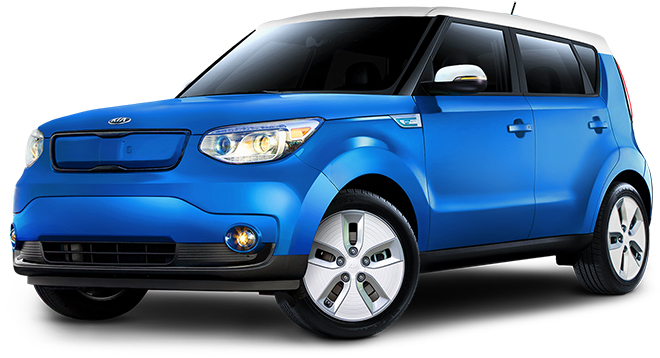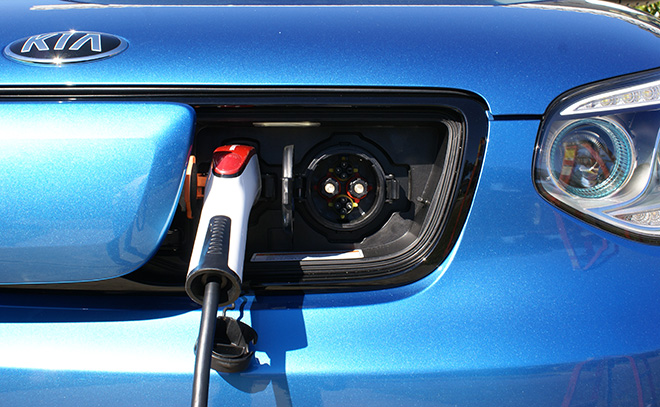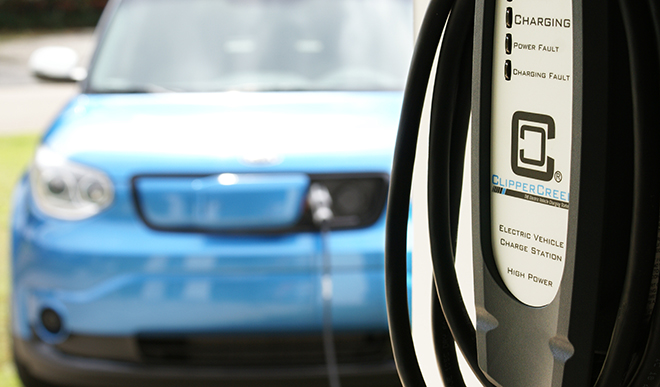Charged faithfully reports on every new plug-in vehicle that comes out, and while there are reasons to be excited about pretty much all of them, there’s always a question lingering in the background: Does this manufacturer plan to actively market its new EV, or is this just another compliance car, to be produced in limited quantities, sold only in California, and discontinued after a few years?
This time, let’s put that question on the table right away. There are several good reasons to believe that the Kia Soul EV is the real thing. Some in the media have called it a compliance car, but that isn’t strictly accurate, because Kia is not currently required to produce an EV under California’s ZEV mandate. The company won’t be deemed a large-volume manufacturer until 2018, so it isn’t required to build zero-emission vehicles at this time.
It’s also significant that Kia has already invested an estimated $15 million in TV ads for its new EV in 2014, making it second in EV ads only to Nissan, which spent some $31 million on TV ads last year promoting the LEAF, according to the advertising metrics firm iSpot.

Perhaps most encouraging of all, Kia has done its homework, and designed a compelling vehicle with features designed to make it stand out from the competition. This is not Kia’s first EV – the Ray EV has been on sale in Korea for a couple of years. The company has applied the lessons learned from that vehicle, and also taken into account the common complaints about other EVs. The Soul has a range of 93 miles, the longest in the sub-Tesla segment, and it has a reasonable amount of cargo space – a sore point with other models. It comes with CHAdeMO DC fast charging as a standard feature.
These are all encouraging signs that Kia is serious about selling its new EV. And, after driving the Soul EV and comparing it to the competition, we’re confident that the company could be quite successful in doing so.

A spirited soul
As EV Product Manager Steve Kosowski told Charged, Kia decided several years ago that the Soul was the right model to electrify. With its practical design and distinctive looks, it’s one of the company’s most popular offerings, and has a cool cachet among the young and hip. “From a design and imagery standpoint, it made a lot of sense,” said Kosowski. “Then, from a packaging point of view, it made even more sense because we have a lot of space under the floor to package the battery.” The Soul’s sill height and cabin height allow the battery to be placed at the bottom of the vehicle, which not only improves handling, but gives the car a roomy interior with little battery intrusion.
Most of the electrifying automakers seem to agree that a compact hatchback is the most popular form factor among those buyers who are likely to be interested in an EV. “The actual footprint of the car, the size of the car, works really well whether you’re in a metro city in the US, Europe, or Asia,” said Kosowski. “So, globally, the car made a lot of sense.”

Deliveries of the Soul EV began in South Korea in May 2014, followed shortly by selected markets in Europe (it’s selling “exceptionally well” in Norway). It went on sale in October in California, with plans to expand to Oregon and a few East Coast markets later. “We’re putting together our launch and roll-out plans for those markets, but the issue is actually getting enough cars,” Kosowski told us. “As soon as we can get the supply, we’re going to start selling the car outside of California. What we don’t want to do is starve our California dealers after they’ve already invested in chargers and tools and training. The Soul EV is the first electric car we’ve sold outside of Korea. So, we want to make sure that the quality is there, that the suppliers and the distributors and the dealers and everybody in the whole chain is ready and there are no problems.”
After we spoke with Kosowski, Orth Hedrick, VP of Product Planning, told AutoblogGreen that customer demand has inspired Kia to accelerate its roll-out plans. “We went back to the factory and told them it’s doing very well and it’s now expanded beyond an EV, it’s something bigger,” he said. “It’s helping us get a dialogue with a completely new, different customer that we normally wouldn’t see in a Kia store.”
“When we looked at it originally, we were trying to go beyond the compliance part,” he said. “We understood, of course, that we had to do it, but we wanted to showcase something that was really strong for us, which is the Soul, and we thought it would help build out the Soul family and bring more people to see us and that’s exactly what’s happening. It was a little more than compliance but I think we were kind of shocked at how well it was received. It’s been a huge hit.”
Hedrick conceded that Kia was not in a position to quickly ramp up production, but said the company hopes to announce a plan by April that will include wider availability than originally planned.

Don’t forget the dealers
One large, and underappreciated, stumbling block to EV sales is the lack of knowledge and enthusiasm among dealers. Kia is addressing this with a program to qualify its dealers, who must meet specific requirements on both the sales and technical sides before they can sell the car. Before launch, Kia organized a couple of special training events for the Soul EV. “Dealers, sales folks and management all got together at an off-site location, and went through all of the nuances of the Soul EV, and they drove cars, and so on. We declared that there must be two salesmen and two technicians. But, as it turned out, the dealers pretty much sent every available sales person to go through the training, which was, to us, a good sign. The dealers had to buy tools to service the cars…and they also had to put in a minimum of three Level 2 chargers. We installed a DC fast charger at each dealer – we’re using an ABB Terra 53 CJ, which has a CCS nozzle and a CHAdeMO nozzle.”

Like its Japanese counterparts, the Soul EV uses CHAdeMO fast charging. However, Kia decided to install dual-standard fast chargers at its dealership locations. “We looked at both standards – it was about three years ago when we needed to make that decision,” said Kosowski. “At the time, there was some genuine interest in CCS. Then we looked at the volume of CHAdeMO chargers in the US, and we thought the prudent thing to do was to fit the car with the CHAdeMO port, and it seems to be the right decision. I think there’s a growing proliferation of CCS devices, but a lot of new chargers are fitted with both nozzles. It’s kind of like a gas pump, where you you’ve got a diesel nozzle and a gasoline nozzle.”
“On the dealer side of the equation, we wanted to make a long-term investment, so if you’ve got a $30,000 charger and you’ve got the choice to offer both ports, it’s prudent to do so. The dealer can charge a Soul EV, a LEAF or an i-MiEV. But, if somebody wheels up in an i3, a Chevy Spark or an e-Golf, you’ve got the option to charge them. If he takes one of those cars in trade in the next ten years, he has the ability to recharge that car. Finally, from a business point of view, all of our chargers at the dealers are networked. We use Greenlots, and if the dealer wants to charge the customer to recharge his EV, he can – it’s up to the dealer. But, at least with the twin-port DC charger, he can charge competitive EVs on his property. On the other side of it, that charger will attract EV customers to the dealership, and if they park their e-Golf or their i3 for twenty minutes while they recharge, it’s an opportunity for the dealer to give them a Soul EV to test-drive.”
Under the hood
The Soul has a couple of strong selling points vis a vis the other pure EVs on the US market. “It’s got 93 miles of range, and that’s more than any other EV out there, except for Model S [and a couple of now-discontinued compliance cars],” said Kosowski. “The car starts with a great design, it’s a cool, iconic car, so there’s a little bit of a design statement there. Also, the car has some functioning utility to it, and that differentiates us from other EVs out there. I’ve talked with 50 or 60 Soul EV customers, who say ‘I looked at a LEAF, or an e-Golf, or an i3, but your car drives wonderfully, it’s very quiet, the battery’s down low, so it feels planted, and it looks cool, but it’s also got this utility factor to it that those others don’t have.’ Some people have even said, ‘I’ve got a first-generation RAV4 EV – remember those? This Soul EV has about as much space on the inside as my RAV4 EV.’”
The Soul’s electric powertrain technology was developed by an R&D organization that is shared by both Hyundai and Kia. “At the Nanyang R&D center, there’s a couple of big buildings where they do nothing but electrification engineering and development,” Kosowski told us. “The engineers are working on motors and controllers, batteries, fuel cells…they’re just engineering and developing electromobility.” Outside the engineers’ domain, the two Korean automakers are competitors. “They are two separate entities – we don’t talk to one another. In Korea, there’s a Kia building and a Hyundai building – we call them the Twin Towers. There is an ownership relationship, but the management of the two companies is essentially independent.”
The Kia Ray, sold only in Korea, is “kind of like the original Scion XB, in the sense that it’s a very small, A-segment car, very boxy. It’s got a sliding door on one side, and hinged doors on the other side.” The EV version represents a small program, intended for the local market, with the purpose of testing and developing a commercial EV.
The Soul’s 27 kWh battery pack has a specific energy of 200 Wh/kg. The cells, made by SK Innovation, feature a nickel cobalt manganese cathode (similar to those used in the i3 and next-gen Volt) and a carbon graphite anode, both bathed in a gel electrolyte. Kia’s engineers worked hard to give the battery a stable “distance to empty” (meaning that the remaining range decreases at a fairly uniform rate, with no unpleasant surprises), and long life with little degradation over time (although only several years of service will reveal how well they succeeded at this goal). Underneath the battery pack are 5 steel cross-members that help support it and protect it from intrusion.
The AC synchronous permanent-magnet motor is liquid-cooled, and musters 109 hp and 210 lb-ft of torque. A plastic panel where the front grill would be slides open to reveal a J1772 and a CHAdeMO plug. The 6.6 kW onboard charger can be programmed to charge at specific times, in order to take advantage of off-peak electric rates, and the climate control system can be set to pre-condition the cabin at any desired time (these features can also be controlled from a smartphone). All this, and today’s vast range of navigation, entertainment and communications options, is accessed through the 8-inch touchscreen, which also offers a rear camera display when in reverse. The Uvo application shows the locations of the nearest charging stations.
Those clever hamsters at Kia found many ways to increase efficiency and squeeze out a few more miles of range. The combined heating and AC unit works by way of a heat pump, reducing HVAC energy consumption by 27% compared to a traditional system. There’s a button to select driver-only ventilation, which can save a little juice, as well as air induction control, which monitors the outside temperature, and runs the AC compressor only when necessary. A full front-to-rear belly pan improves aerodynamic drag by 5%, and also makes the interior quieter. Kia assures us that the super-low-rolling-resistance tires are 10% more efficient than the mere low-rolling-resistance type.
The Soul EV uses Kia’s 3rd-generation regenerative braking system, the same used on the Optima hybrid. A neat feature: there are two levels of regen, which you select with the gear lever. In D, the Soul drives like a regular car, coasting when you take your foot off the pedal. In B, the regen kicks in as soon as you take your foot off, allowing a “one-pedal” driving technique and maximizing range.
At 105 MPGe, the Kia’s efficiency rating lies in the middle of the pack: ahead of the much larger Model S, but exceeded by the VW e-Golf (116 MPGe) and the efficiency leader, the BMW i3 (124 MPGe).
Cargo capacity is 18.8 cubic feet with the rear seats up, or 49.5 cubic feet with the seats down. With the seats down, you have a nice open space (none of the odd-shaped protrusions found in some EVs), and the back is square, not sloped like most hatchbacks, so hauling tall objects is no problem. There’s a small compartment under the cargo deck for storing the charging adapters.
Like several other automakers these days, Kia strives to reduce the amount of fossil fuels consumed in the manufacturing process. The Soul EV has earned validation from Underwriters’ Laboratories for its bio-based organic content. It contains 53 pounds of bio-based materials – the plastics that make up the headliner and interior trim are made from corn and sugar.
There are no options as such, and just two trim levels: the Soul EV, and the Soul EV Plus. The Plus adds leather seat trim, folding side mirrors, front and rear park sense, and cooled front seats (the base model has only heated front seats). MSRP for the base model is $34,500 (before any incentives). It’s also available for lease at $249 a month for 36 months, with $1,999 due at signing.
Kia has three official charging partners – Soul EV buyers can choose a charger from Bosch, Aerovironment or Leviton, and the cost of the charger can be included in a lease.
When it comes to the all-important road test, the Soul EV passed with flying colors. Charged drove one for two weeks, and we found it a joy to live with. When you punch the pedal it leaps ahead enthusiastically, just as an EV should. Handling is smooth as silk, turning radius is excellent, and all the high-tech goodies work as advertised.

A maturing market
The EV market is getting more crowded all the time, but Kia’s offering is a very strong contender. The Soul EV’s generous interior space and slightly better range give it an edge over its natural competitors, the LEAF and the i3 (VW’s new e-Golf may be the EV to watch, however, with a similar range to the Soul, and even more cargo space – 52.7 cubic feet with seats folded).
As everyone with a TV set knows, automakers put a lot of money into TV ad campaigns, but only Nissan, GM and, lately, BMW have done any substantial advertising for their electric models. It’s no coincidence that these are the only companies that have had any substantial EV sales (apart from Tesla, which doesn’t seem to need to do anything that other automakers do). Kia’s hamsters are already hard at work selling the Soul EV.
“The top management within KMA wanted to get behind the car, they wanted to promote it, they wanted to essentially let the market know that we have a green EV based on Soul. We wanted to attach the hamster theme as well, since we’ve gotten a lot of traction from that strategy in the marketplace. The agency we work with is David and Goliath, and they’re some of the best marketing and advertising people in the industry. There’s a great, wonderful, creative process that’s a mix of some KMA folks and David and Goliath folks, and they came up with this theme. It was presented to management, and we were able to get the funding and the marketing support behind it, and it seems to have worked.”
Does Kia have any other plug-in models in the pipeline? Kosowski wouldn’t comment, but at the last Detroit Auto Show, Ki-Sang Lee, a Senior VP who’s head of the Hyundai-Kia R&D Center for “eco-friendly vehicles,” said that the company is developing a third-generation hybrid platform. The second generation is represented by the 2016 Hyundai Sonata Hybrid and Plug-In Hybrid, which are to go on sale this year. And a new Kia Optima Hybrid and Plug-in Hybrid are expected to be introduced later this year.
This article originally appeared in Charged Issue 17 – January/February 2015





















































